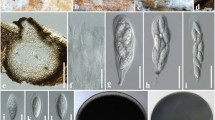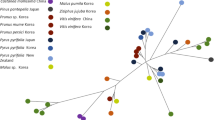Abstract
Chapter 1: This chapter gives an up-to-date account of the taxonomy of fungi, referring to the recent AFTOL (‘assembling the fungal tree of life') scheme. For each group, changes proposed since the publication of Mycota VIIA and VIIB in 2001 are discussed. Considerations include groups which no longer belong to the Fungi in a taxonomic sense, but continue to be studied by mycologists. Although AFTOL has potential to become the first global taxonomic scheme for fungi, there are several factors which could destabilise it. Likely or possible problem cases are indicated. This as indeed any previous ‘natural’ (i.e. phylogeny-based) classification scheme of fungi has grouped together biologically dissimilar species whilst separating others which show striking similarities in their life styles or morphologies. The impact of such rearrangements for the teaching of mycology is discussed.
Access this chapter
Tax calculation will be finalised at checkout
Purchases are for personal use only
Similar content being viewed by others
References
Adl S, et al (2005) The new higher level classification of eukaryotes with emphasis on the taxonomy of protists. J Eukaryot Microbiol 52:399–451
Adl S, et al (2007) Diversity, nomenclature, and taxonomy of protists. Syst Biol 56:684–689
Aime MC, Matheny PB, Henk DA, Frieders EM, Nilsson RH, Piepenbring M, McLaughlin DJ, Szabo LJ, Begerow D, Sampaio JP, Bauer R, Weiss M, Oberwinkler F, Hibbett D (2006) An overview of the higher-level classification of Pucciniomycotina based on combined analyses of nuclear large and small subunit rDNA sequences. Mycologia 98:869–905
Alexopoulos CJ, Mims CW, Blackwell M (1996) Introductory mycology, fourth edn. Wiley, New York
Archibald JM, Keeling PJ (2004) Actin and ubiquitin protein sequences support a cercozoan/foraminiferan ancestry for the plasmodiophorid plant pathogens. J Eukaryot Microbiol 51:113–118
Baldauf SL, Roger AJ, Wenk-Siefert I, Doolittle WF (2000) A kingdom-level phylogeny of eukaryotes based on combined protein data. Science 290:972–977
Bauer R, Oberwinkler F, Vánky K (1997) Ultrastructural markers and systematics in smut fungi and allied taxa. Can J Bot 75:1273–1314
Bauer R, Begerow D, Sampaio JP, Weiss M, Oberwinkler F (2006) The simple-septate basidiomycetes: a synopsis. Mycol Progr 5:41–66
Begerow D, Bauer R, Oberwinkler F (1997) Phylogenetic studies on the nuclear large subunit ribosomal DNA of smut fungi and related taxa. Can J Bot 75:2045–2056
Begerow M, Bauer R, Oberwinkler F (2002) The Exobasidiales: an evolutionary hypothesis. Mycol Prog 1:187–199
Begerow D, Stoll M, Bauer R (2006) A phylogenetic hypothesis of Ustilaginomycotina based on multiple gene analyses and morphological data. Mycologia 98:906–916
Berbee ML, Taylor JW (2001) Fungal molecular evolution: gene trees and geologic time. In: McLaughlin DJ, McLaughlin EG, Lemke PA (eds) The Mycota VIIB: systematics and evolution. Springer, Heidelberg, pp 229–245
Binder M, Hibbett DS (2006) Molecular systematics and biological diversification of Boletales. Mycologia 98:971–981
Binder M, Hibbett DS, Larsson K-H, Larsson E, Langer E, Langer G (2005) The phylogenetic distribution of resupinate forms across the major clades of mushroom-forming fungi (Homobasidiomycetes). Syst Biodiv 3:113–157
Blackwell M, Hibbett DS, Taylor JW, Spatafora JW (2006) Research coordination networks: a phylogeny for kingdom Fungi (Deep Hypha). Mycologia 98:829–837
Cafaro M (2005) Eccrinales (Trichomycetes) are not fungi, but a clade of protists at the early divergence of animals and fungi. Mol Phylogen Evol 35:21–34
Dick MW (2001) Straminipilous fungi. Kluwer, Dordrecht
Eriksson OE, Winka K (1997) Supraordinal taxa of the Ascomycota. Myconet 1:1–16
Fast NM, Xue L, Bingham S, Keeling PJ (2002) Re-examining alveolate evolution using multiple protein molecular phylogenies. J Eukaryot Microbiol 49:30–37
Fell JW, Boekhout T, Fonseca A, Sampaio JP (2001) Basidiomycetous yeasts. In: McLaughlin DJ, McLaughlin EG, Lemke PA (eds) The Mycota VIIB: systematics and evolution. Springer, Heidelberg, pp 3–35
Geiser DM, LoBuglio KF (2001) The monophyletic Plectomycetes: Ascosphaerales, Onygenales, Eurotiales. In: McLaughlin DJ, McLaughlin EG, Lemke PA (eds) The Mycota VIIA: systematics and evolution. Springer, Heidelberg, pp 201–219
Geiser DM, Gueidan C, Miadlikowska J, Lutzoni F, Kauff F, Hofstetter V, Fraker E, Schoch CL, Tibell L, Untereiner WA, Aptroot A (2006) Eurotiomycetes: Eurotiomycetidae and Chaetothyriomycetidae. Mycologia 98:1953–1064
Hakariya M, Hirose D, Tokumasu S (2007) A molecular phylogeny of Haptoglossa species, terrestrial peronosporomycetes (oomycetes) endoparasitic on nematodes. Mycoscience 48:169–175
Hansen K, Pfister DH (2006) Systematics of the Pezizomycetes – the operculate discomycetes. Mycologia 98:1029–1040
Hibbett DS (2006) A phylogenetic overview of the Agaricomycotina. Mycologia 98:917–925
Hibbett DS, Thorn RG (2001) Basidiomycota: Homobasidiomycetes. In: McLaughlin DJ, McLaughlin EG, Lemke PA (eds) The Mycota VIIB: systematics and evolution. Springer, Heidelberg, pp 121–168
Hibbett DS, Pine EM, Langer E, Langer G, Donoghue MJ (1997) Evolution of gilled mushrooms and puffballs inferred from ribosomal DNA sequences. Proc Natl Acad Sci USA 94:12002–12006
Hibbett DS, et al (2007) A higher-level phylogenetic classification of the Fungi. Mycol Res 111:509–547
Hosaka K, Bates ST, Beever RE, Castellano MA, Colgan W, Domínguez LS, Nouhra ER, Geml J, Giachini AJ, Kenney SR, Simpson NB, Spatafora JW, Trappe J (2006) Molecular phylogenetics of the gomphoid–phalloid fungi with an establishment of the new subclass Phallomycetidae and two new orders. Mycologia 98:949–959
Hudspeth DSS, Stenger D, Hudspeth MES (2003) A cox2 phylogenetic hypothesis for the downy mildews and white rusts. Fungal Divers 13:47–57
Inagaki Y, Susko E, Fast NM, Roger AJ (2004) Covarion shifts cause a long-branch attraction artifact that unites Microsporidia and Archaebacteria in EF-1α phylogenies. Mol Biol Evol 21:1340–1349
James TY, et al (2006a) Reconstructing the early evolution of fungi using a six-gene phylogeny. Nature 443:818–822
James TY, Letcher PM, Longcore JE, Mozley-Standridge SE, Powell MJ, Griffith GW, Vilgalys R (2006b) A molecular phylogeny of the flagellated fungi (Chytridiomycota) and description of a new phylum (Blastocladiomycota). Mycologia 98:860–871
Keeling PJ, Fast NM (2002) Microsporidia: biology and evolution of highly reduced intracellular parasites. Annu Rev Microbiol 56:93–116
Keeling PJ, Luker MA, Palmer JD (2000) Evidence from beta-tubulin phylogeny that Microsporidia evolved from within the Fungi. Mol Biol Evol 17:23–31
Keeling PJ, Burger G, Durnford DG, Lang BF, Lee RW, Pearlman RE, Roger AJ, Gray MW (2005) The tree of eukaryotes. Trends Ecol Evol 20:670–676
Kessin RH (2001) Dictyostelium. Evolution, cell biology, and the evolution of multicellularity. Cambridge University Press, Cambridge
Kirk PM, Cannon PF, David JC, Stalpers JA (eds) (2001) Ainsworth and Bisby's dictionary of the fungi, 9th edn. CABI, Wallingford
Kurtzman CP, Sugiyama J (2001) Ascomycetous yeasts and yeastlike taxa. In: McLaughlin DJ, McLaughlin EG, Lemke PA (eds) The mycota VIIA: systematics and evolution. Springer, Heidelberg, pp 179–200
Larsson K-H, Parmasto E, Fischer M, Langer E, Nakasone KK, Redhead SA (2006) Hymenochaetales: a molecular phylogeny for the hymenochaetoid clade. Mycologia 98:926–936
Liu YJ, Hodson MC, Hall BD (2006) Loss of the flagellum happened only once in the fungal lineage: phylogenetic structure of Kingdom Fungi inferred from RNA polymerase II subunit genes. BMC Evol Biol 6:74
Lutz M, Bauer R, Begerow D, Oberwinkler F (2004) Tuberculina – Thanatophytum/Rhizoctonia crocorum – Helicobasidium: a unique mycoparasitic–phytoparasitic life strategy. Mycol Res 108:227–238
Matheny PB, et al (2006) Major clades of Agaricales: a multilocus phylogenetic overview. Mycologia 98:982–995
Matheny PB, et al (2007) Contributions of rpb1 and tef1 to the phylogeny of mushrooms and allies (Basidiomycota, Fungi). Mol Phylogen Evol 43:430–451
McLaughlin DJ, McLaughlin EG, Lemke PA (eds) (2001) The mycota VIIA, VIIB: systematics and evolution. Springer, Heidelberg
Miadlikowska J, et al (2006) New insights into classification and evolution od the Lecanoromycetes (Pezizomycotina, Ascomycota) from phylogenetic analyses of three ribosomal RNA- and two protein-encoding genes. Mycologia 98:1088–1103
Miller SL, Larsson E, Larsson K-H, Verbeken A, Nuytinck J (2006) Perspectives in the new Russulales. Mycologia 98:960–970
Moncalvo J-M, Vilgalys R, Redhead SA, Johnson JE, James TY, Aime MC, Hofstetter V, Verduin SJW, Larsson E, Baroni TJ, Thorn RG, Jacobsson S, Clémençon H, Miller OK (2002) One hundred and seventeen clades of euagarics. Mol Phylogen Evol 23:357–400
Moncalvo J-M, Nilsson RH, Koster B, Dunham SM, Bernauer T, Matheny PB, Porter TM, Margaritescu S, Weiss M, Garnica S, Danell E, Langer G, Langer E, Larsson E, Larsson K-H, Vilgalys R (2006) The cantharelloid clade: dealing with incongruent gene trees and phylogenetic reconstruction methods. Mycologia 98:937–948
Morton JB, Benny GL (1990) Revised classification of arbuscular mycorrhizal fungi (Zygomycetes): a new order, Glomales, two new suborders, Glomineae and Gigasporineae, and two new families, Acaulosporaceae and Gigasporaceae, with an emendation of Glomaceae. Mycotaxon 37:471–491
Nishida H, Sugiyama J (1994) Archiascomycetes: detection of a major new lineage within the Ascomycota. Mycoscience 35:361–366
Redecker D, Raab P (2006) Phylogeny of the Glomeromycota (arbuscular mycorrhizal fungi): recent developments and new gene markers. Mycologia 98:885–895
Riethmüller A, Voglmayr H, Göker M, Weiss M, Oberwinkler F (2002) Phylogenetic relationships of the downy mildews (Peronosporales) and related groups based on nuclear large subunit ribosomal DNA sequences. Mycologia 94:834–849
Samuels GJ, Blackwell M (2001) Pyrenomycetes – fungi with perithecia. In: McLaughlin DJ, McLaughlin EG, Lemke PA (eds) The mycota VIIA: systematics and evolution. Springer, Heidelberg, pp 221–255
Schoch CL, Shoemaker RA, Seifert KA, Hambleton S, Spatafora JW, Crous PW (2006) A multigene phylogeny of the Dothideomycetes using four nuclear loci. Mycologia 98:1041–1052
Schüssler A, Schwarzott D, Walker C (2001) A new fungal phylum, the Glomeromycota: phylogeny and evolution. Mycol Res 105:1413–1421
Simpson AGB, Roger AJ (2004) The real ‘kingdoms’ of eukaryotes. Curr Biol 14:R693–R696
Spatafora JW, et al (2006) A five-gene phylogeny of Pezizomycotina. Mycologia 98:1018–1028
Sugiyama J, Hosaka K, Suh S-U (2006) Early diverging Ascomycota: phylogenetic divergence and related evolutionary origins. Mycologia 98:996–1005
Suh S-O, Blackwell M, Kurtzman CP, Lachance M-A (2006) Phylogenetics of Saccharomycetales, the ascomycete yeasts. Mycologia 98:1006–1017
Swann EC, Taylor JW (1993) Higher taxa of basidiomycetes: an 18S rRNA perspective. Mycologia 85:923–936
Swann EC, Frieders EM, McLaughlin DJ (2001) Urediniomycetes. In: McLaughlin DJ, McLaughlin EG, Lemke PA (eds) The mycota VIIB: systematics and evolution. Springer, Heidelberg, pp 37–56
Tanabe Y, Watanabe MM, Sugiyama J (2002) Are Microsporidia really related to Fungi? A reappraisal based on additional gene sequences from basal fungi. Mycol Res 106:1380–1391
Tanabe Y, Saikawa M, Watanabe MM, Sugiyama J (2004) Molecular phylogeny of Zygomycota based on EF-1α and RPB1 sequences: limitations and utility of alternative markers to rDNA. Mol Phylogen Evol 30:438–449
Thines M, Göker M, Telle S, Ryley M, Mathur K, Narayana YD, Spring O, Thakur RP (2008) Phylogenetic relationships of graminicolous downy mildews based on cox2 sequence data. Mycol Res 112:345–351
Tsuneda A, Currah RS (2004) Ascomatal morphogenesis in Myxotrichum arcticum supports the derivation of Myxotrichaceae from a discomycetous ancestor. Mycologia 96:627–635
Ustinova I, Krienitz L, Huss VAR (2000) Hyaloraphidium curvatum is not a green alga, but a lower fungus; Amoebidium parasiticum is not a fungus, but a member of the DRIPs. Protist 151:253–262
Villa NO, Kageyama K, Asano T, Suga H (2006) Phylogenetic relationships of Pythium and Phytophthora species based on ITS rDNA, cytochrome oxidase II and β-tubulin gene sequences. Mycologia 98:410–422
Wang Z, Johnston PR, Takamatsu S, Spatafora JW, Hibbett DS (2006) Toward a phylogenetic classification of the Leotiomycetes based on rDNA data. Mycologia 98:1065–1075
Webster J, Weber RWS (2007) Introduction to fungi, 3rd edn. Cambridge University Press, Cambridge
Weiss M, Selosse M-A, Rexer K-H, Urban A, Oberwinkler F (2004) Sebacinales: a hitherto overlooked cosm of heterobasidiomycetes with a broad mycorrhizal potential. Mycol Res 108:1003–1010
Wells K, Bandoni RJ (2001) Heterobasidiomycetes. In: McLaughlin DJ, McLaughlin EG, Lemke PA (eds) The mycota VIIB: systematics and evolution. Springer, Heidelberg, pp 86–120
White MW, James TY, O'Donnell K, Cafaro MJ, Tanabe Y, Sugiyama J (2006) Phylogeny of the Zygomycota based on nuclear ribosomal sequence data. Mycologia 98:872–884
Zhang N, Castlebury LA, Miller AN, Huhndorf SM, Schoch CL, Seifert KA, Rossman AY, Rogers JD, Kohlmeyer J, Volkmann-Kohlmeyer B, Sung G-H (2006) An overview of the systematics of the Sordariomycetes based on a four-gene phylogeny. Mycologia 98:1076–1087
Author information
Authors and Affiliations
Corresponding author
Editor information
Editors and Affiliations
Rights and permissions
Copyright information
© 2009 Springer-Verlag Berlin Heidelberg
About this chapter
Cite this chapter
Weber, R.W. (2009). Recent Developments in the Molecular Taxonomy of Fungi. In: Anke, T., Weber, D. (eds) Physiology and Genetics. The Mycota, vol 15. Springer, Berlin, Heidelberg. https://doi.org/10.1007/978-3-642-00286-1_1
Download citation
DOI: https://doi.org/10.1007/978-3-642-00286-1_1
Published:
Publisher Name: Springer, Berlin, Heidelberg
Print ISBN: 978-3-642-00285-4
Online ISBN: 978-3-642-00286-1
eBook Packages: Biomedical and Life SciencesBiomedical and Life Sciences (R0)




